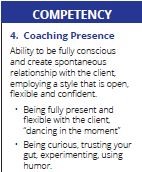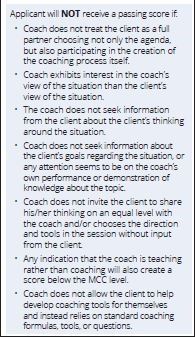Being open, flexible, and confident while fully conscious of the client is the coaching competency of presence. It includes being curious, trusting your instincts, experimenting, and using humor. 
If a coach is thinking and analyzing more than being responsive, the competency is minimally acceptable. The more the coach empowers the client driving the agenda as well as the coaching, the better. When the coach moves between objective and subjective, and rather than pushing for a solution, is in the moment with the client, the coaching is increasingly demonstrating coaching presence. When the coach is completely connected with how the client learns and what they have to teach, then the coach is being curious and trusts the value of the process.
Failing the competency happens if the coach is significantly interested in their own view, does not seek information from the client and respond to it, or is focused on their own performance. At higher credentialing levels, the coach will fail if they are overly reliant on standard questions, is teaching, or fails to empower the client to develop their own tools.
 In coach training, learning how to recognize the way someone thinks, processes, decides, and learns lays the foundation for presence. Learning with questionnaires is standard because it prepares the coach for working without questionnaires as they further enhance this competency because of the experience with how to ask questions. At the highest level, the coach is formulating and asking questions in the moment.
In coach training, learning how to recognize the way someone thinks, processes, decides, and learns lays the foundation for presence. Learning with questionnaires is standard because it prepares the coach for working without questionnaires as they further enhance this competency because of the experience with how to ask questions. At the highest level, the coach is formulating and asking questions in the moment.




